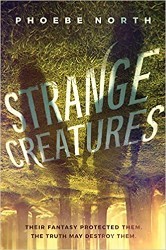In Thistlefoot, Nethercott converts painful remembrance itself into a fierce, lyrical fable. As the novel opens, events both recent and past have already taken up residence in the bodies of Isaac and his sister, Bellatine. Isaac hides from himself as the Chameleon King, whose street performances ventriloquize others. Bellatine, a cabinetmaker, works with wood, terrified to lose control of her hands, which can heat and bleed with life-giving power. Memory also pulses in the hearth fire and ceiling mural of a cottage that walks (and runs and roosts) on chicken feet — a home that Isaac and Bellatine have inherited from Baba Yaga, the great-great-grandmother whom they never knew. Memory is likewise what motivates the smoky spectral Longshadow Man to come after them, determined as he is to erase all knowledge of what happened in the Russian shtetl of Gedenkrovka, now Ukraine, in 1919.
Wondrous details and plot twists generate surprise throughout Nethercott’s short chapters, which are narrated by various characters past and present. Even Baba Yaga’s house on chicken feet — whom Isaac and Bellatine name Thistlefoot and speak to in Yiddish when they want her to move — has her own cocky say. Brother and sister eventually turn Thistefoot into a traveling puppet theater and begin to research the mysteries she holds within.
The most poignant passages limn Isaac’s and Bellatine’s growing understanding of each other and themselves, along with humanizing personal tales by the Baba Yaga witch of folklore and Thistlefoot. We sense Baba Yaga’s loneliness, her joy as she creates two daughters from teeth and rugelach, and her horrific loss during a savage pogrom. We come to find that Isaac feels guilty for losing a friend while out vagabonding. And we see that Bellatine feels guilty, too, for the torture she once inflicted when trying to resuscitate an injured deer — such that, now, she cannot let herself act on her love for the stone statue of a girl she has brought to life.
On the run with Thistlefoot, Isaac and Bellatine join forces with three outsiders in a black bus, who have been tracking and rescuing victims from the wake of destruction and death that the Longshadow Man has left along the way. In a predictable pattern, the villain tricks vulnerable people into drinking an elixir from his blue bottle, which fills them with nightmare smoke, sets ghostly passengers upon their backs, and incites them into self-justifying frenzies of individual and mob violence.
Nethercott’s prose is passionate and unputdownable, with the dramatic visual strength of a Tim Burton film. As Thistlefoot asks, “How long does it take for the body to realize it is safe? … There is no such thing as a ghost of the dead. Yet suffering has a way of begging to be remembered.” Not until they acknowledge the past, in other words, can these young protagonists live resonant lives.
Sharon Elswit, author of The Jewish Story Finder and a school librarian for forty years in NYC, now resides in San Francisco, where she shares tales aloud in a local JCC preschool and volunteers with 826 Valencia to help students write their own stories and poems.





